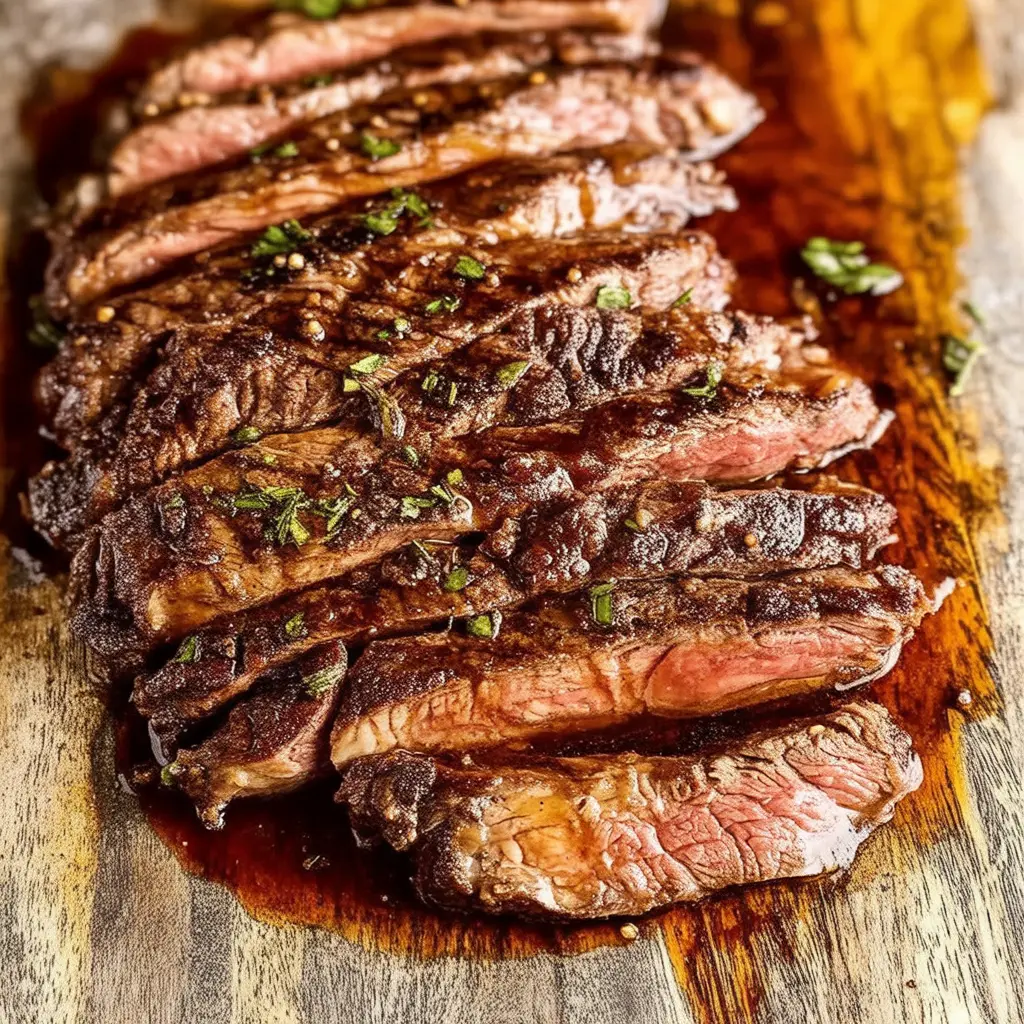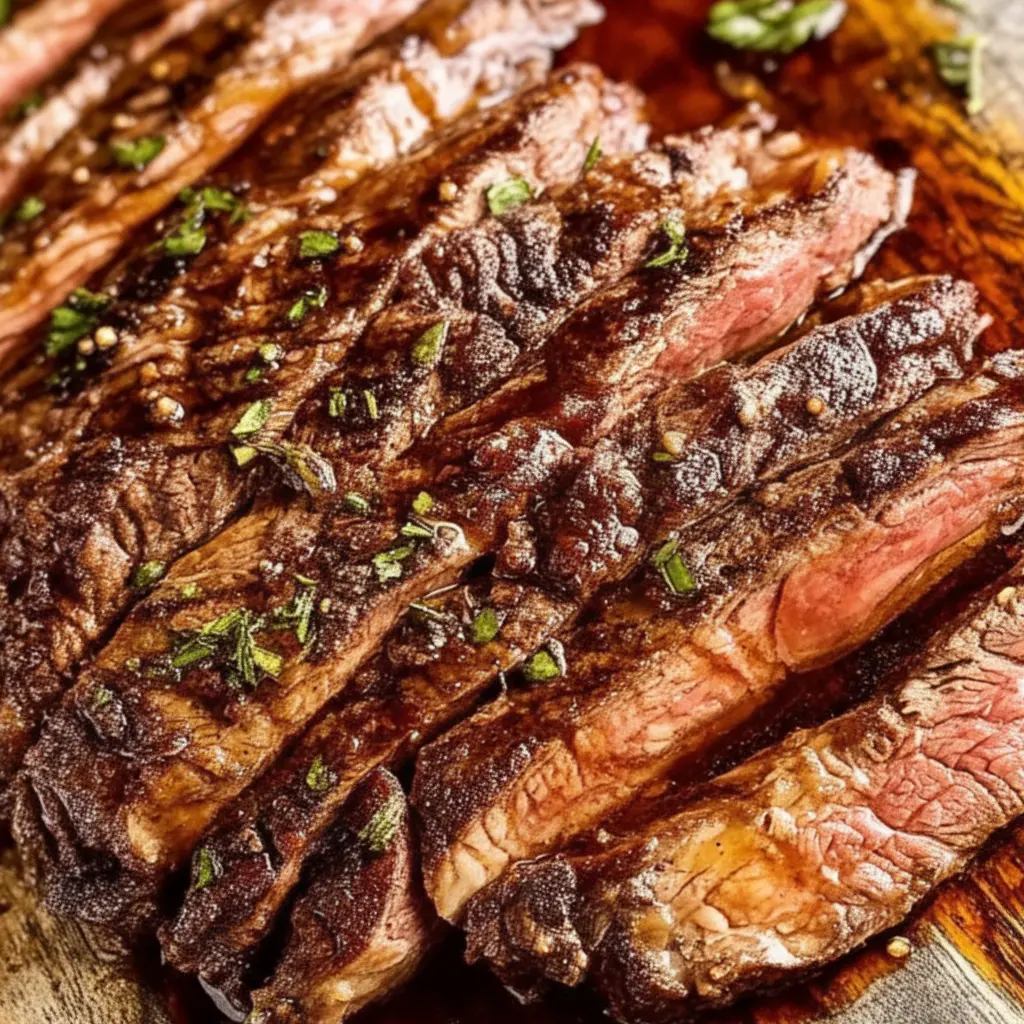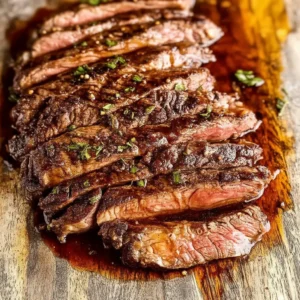I still remember the first time I tried marinating steak. I was twenty-three, newly married, and convinced I could turn a cheap cut of meat into something steakhouse-worthy—armed with nothing but a bottle of Italian dressing and a lot of optimism. It wasn’t inedible, but let’s just say we chewed a lot that night. I didn’t know then what I’ve learned through years of trial, error, and small kitchen triumphs: a great marinade isn’t just about flavor—it’s about transforming texture, tenderness, and the whole eating experience.
This steak marinade came into my life about ten years ago, when a neighbor named Frank—gruff, retired Army, and surprisingly poetic about food—invited us over for backyard grilling. He handed me a plate of the most tender, flavorful flank steak I’d ever tasted. I must’ve looked stunned because he chuckled and said, “It’s just the marinade, Clara. Nothing fancy. Just right.” Well, Frank was right, and after some coaxing and a few shared beers, he gave me his base recipe. Over the years, I’ve made it my own—tweaking here and there—but the heart of it is still Frank’s: simple ingredients, balanced flavors, and time doing the quiet work of making something special.

Why You’ll Love This Recipe:
- Easy to prepare with pantry staples
- Makes even inexpensive cuts taste like a splurge
- Infuses rich, layered flavor into every bite
- Perfect for grilling, pan-searing, or broiling
- Great for meal prep or make-ahead dinners
Ingredients You’ll Need:
This marinade is all about balance—acid, fat, salt, and sweetness, plus a good punch of aromatics. Here’s what you’ll need:
- Soy sauce (1/3 cup): This is our salty, umami backbone. I’ve used tamari when cooking gluten-free, and it works beautifully.
- Olive oil (1/3 cup): Helps carry the flavors into the meat and keeps it tender. I’ve also used avocado oil without any loss of richness.
- Worcestershire sauce (2 tablespoons): A little goes a long way. It brings that deep, savory depth we crave in steak.
- Balsamic vinegar (2 tablespoons): Frank used red wine vinegar, and it’s lovely too—but balsamic gives just a touch of sweetness and complexity.
- Brown sugar (1 tablespoon): Helps with caramelization and balances the acidity. You can use honey or maple syrup in a pinch.
- Garlic (3 cloves, minced): Fresh is best here. If you’re in a rush, 1 teaspoon of garlic powder will do, but it won’t have quite the same punch.
- Freshly ground black pepper (1 teaspoon): Add more if you like it bold. I’ve made it with cracked peppercorns for an extra bite.
- Optional: red pepper flakes (1/2 teaspoon): If you like a little heat, it adds a gentle background warmth.
How to Make It (Step-by-Step Instructions):
Start by grabbing a medium mixing bowl or a glass measuring cup—something with a spout makes pouring easier. Pour in the soy sauce, olive oil, Worcestershire, and balsamic vinegar. I like to whisk these together first, letting the liquids fully combine before adding the sugar and seasonings. Stir in the brown sugar until it dissolves; this ensures even sweetness and avoids grainy spots on the steak. Add the minced garlic, black pepper, and red pepper flakes if using, and give it one last stir. You’ll notice the smell shifts right away—it’s savory, slightly sweet, and already mouthwatering.
Place your steak—whether it’s flank, skirt, sirloin, or even a good old chuck—into a large zip-top bag or shallow dish. Pour the marinade over the meat, seal it up (or cover, if using a dish), and make sure every inch of the steak is coated. This is where I pause to press out the air and massage the marinade into the meat a bit. Then, it goes in the fridge.
Let it marinate for at least 4 hours, though overnight is ideal. I once forgot about it and left it for 36 hours—too much. The meat started breaking down a little too far and lost its structure. So now I aim for 8 to 12 hours for the sweet spot.
Before cooking, take the steak out of the fridge about 30 minutes early to let it come to room temperature. This helps it cook more evenly. I always pat it dry with paper towels—yes, even though we marinated it lovingly. Surface moisture causes steaming, not searing, and we want that beautiful crust. Cook it your favorite way (grill, pan, or broiler), let it rest for 5–10 minutes, then slice against the grain. That last bit makes a world of difference—cutting with the grain gives you chewy strips; cutting against gives you buttery bites.

Expert Tips for the Best Results:
Marinating isn’t just tossing meat in liquid—it’s a little more deliberate than that. I’ve found that thinner cuts like flank or skirt steak do better with shorter, intense marination (8 to 12 hours), while thicker cuts like ribeye don’t need quite as much time—especially if they’re already well-marbled. Always let the steak come to room temperature before cooking, and never skip the resting time after—it helps the juices redistribute, so you don’t lose all that flavor to your cutting board. And don’t forget to dry the steak before cooking. A dry surface and a hot pan are what make that perfect crust happen.
Variations & Substitutions:
I’ve made this marinade with lemon juice instead of vinegar when I was out—it gave the steak a brighter, slightly tangier note that worked great with grilled vegetables. Once, in the middle of winter, I ran out of fresh garlic and used a spoonful of roasted garlic paste I had frozen in cubes—it added a mellow, earthy depth. For a sweeter twist, I’ve swapped the brown sugar with a little apple cider or even cola in a pinch (Frank swore by that one sometimes). Each change brings a new personality to the dish, and that’s the fun of home cooking—making it your own without fear.
Serving Suggestions:
I like to serve this steak sliced thin, family-style, on a wooden board or a big platter. It’s perfect with a tangle of garlicky green beans or grilled asparagus, and I always throw some crusty bread on the table to catch the juices. For a more complete dinner, I’ll roast some baby potatoes or make a warm farro salad with tomatoes and herbs. This marinade also makes steak sandwich heaven—pile it onto toasted ciabatta with arugula and a swipe of horseradish cream for something special. It’s versatile enough for weeknights and impressive enough for company.
Storage & Reheating Instructions:
If you have leftovers (we rarely do), store them in an airtight container in the fridge for up to three days. I slice the steak before storing, which makes reheating easier. To warm it, I usually toss the slices in a skillet over low heat with a splash of beef broth or water—just enough to keep it from drying out. You won’t get the original crust back, but the flavor holds up beautifully. Avoid the microwave if you can; it tends to toughen things. Cold steak, sliced thin, is also lovely on a salad or tucked into a wrap.
Recipe FAQs (Answered by Clara):
Can I make this ahead of time?
You sure can. I often mix the marinade in the morning and leave the steak soaking all day. The flavor gets better with time, as long as you don’t go overboard past 24 hours.
Does this work with other meats?
Yes! I’ve used it on chicken thighs and even pork chops—it’s just as delicious. Just adjust the marinating time accordingly: less for chicken, maybe a little more for pork.
What cut of steak works best?
Flank steak is my go-to, but skirt steak, flat iron, or sirloin also shine here. Even tougher cuts benefit from this marinade, just be mindful of the slicing and don’t overcook.
Can I freeze the steak in the marinade?
Absolutely. It’s a great freezer meal option. Combine the marinade and raw steak in a freezer bag and freeze flat. Thaw it in the fridge overnight and cook as usual—no need to re-marinate.
Is this marinade very salty?
It’s well-balanced, but if you’re watching sodium, you can use low-sodium soy sauce and dial back the Worcestershire a bit. I’ve done both with good results.

This marinade has become one of those quiet staples in my kitchen—reliable, flexible, and always a hit. It’s more than just a way to flavor meat; it’s a little gift of time and attention that makes dinner feel special. Whether you’re cooking for one or feeding a full table, I hope this recipe brings you the same satisfaction it’s brought me over the years. If you try it, I’d love to hear how it goes—leave a comment, share your tweaks, or just drop a note. And remember: a good meal doesn’t have to be fancy to be memorable. Just make it with care, and it’ll taste like home.
Nutrition Information (Approximate, per serving—based on 6 servings):
Calories: 290
Protein: 28g
Fat: 18g
Carbohydrates: 6g
Sodium: 820mg
Sugar: 3g

Steak Marinade
Ingredients
- ¼ cup soy sauce
- ¼ cup olive oil
- 2 tablespoons Worcestershire sauce
- 2 tablespoons lemon juice or balsamic vinegar
- 2 tablespoons brown sugar or honey
- 3 garlic cloves minced
- 1 teaspoon Dijon mustard optional
- 1 teaspoon black pepper
- ½ teaspoon onion powder
- ¼ teaspoon red pepper flakes optional
- 1 tablespoon chopped fresh rosemary or thyme optional
Instructions
- Mix the marinade: In a medium bowl or jar, whisk together soy sauce, olive oil, Worcestershire sauce, lemon juice, brown sugar, garlic, mustard, and seasonings until well combined.
- Marinate the steak: Place steak in a resealable bag or shallow dish. Pour the marinade over the meat, making sure it’s fully coated. Seal or cover and refrigerate for at least 30 minutes and up to 8 hours.
- Grill or cook as desired: Remove steak from marinade and discard excess. Cook using your preferred method—grill, pan-sear, or broil—until desired doneness is reached.
- Rest and serve: Let the steak rest for 5 minutes before slicing to retain juices. Serve hot.
Notes
- Ideal for ribeye, sirloin, flank, skirt, or New York strip.
- Do not reuse marinade as a sauce unless you boil it first.
- For a smoky flavor, add ½ teaspoon smoked paprika.
- Can be doubled or stored in the fridge for up to 1 week


Leave a Reply